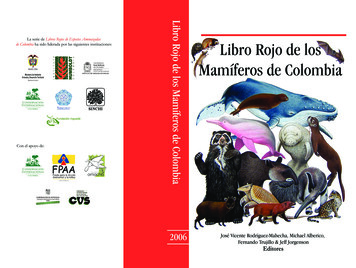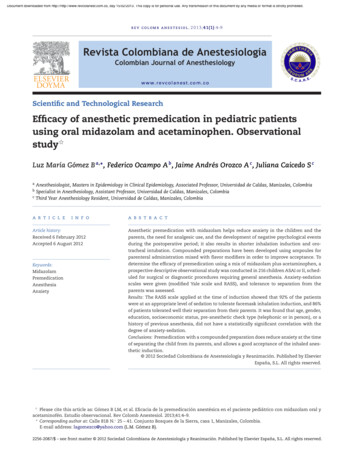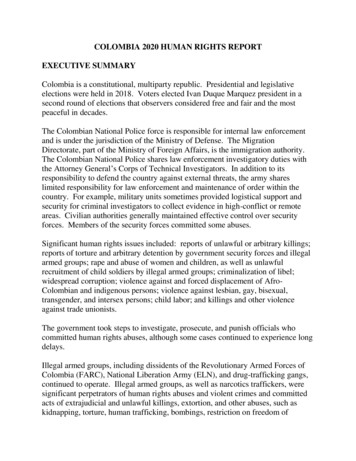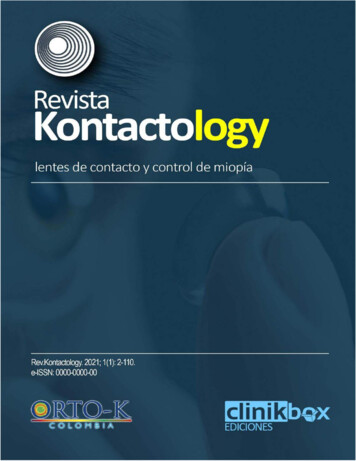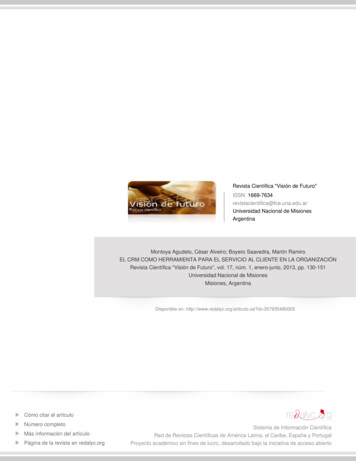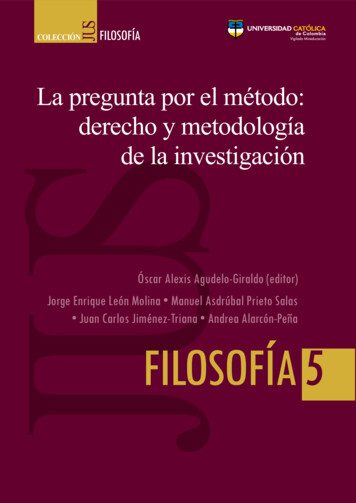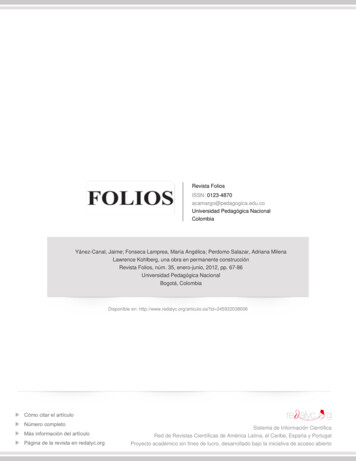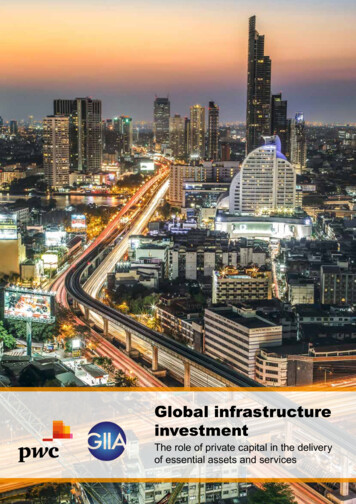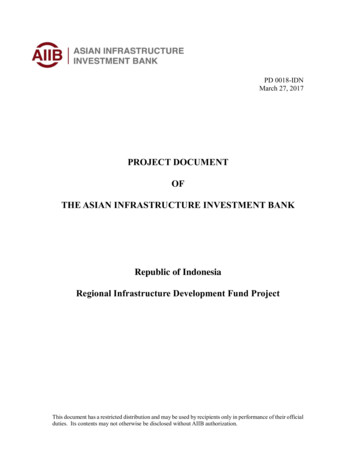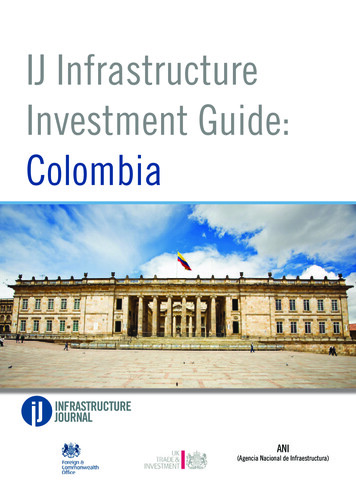
Transcription
IJ InfrastructureInvestment Guide:ColombiaINFRASTRUCTUREJOURNALANI(Agencia Nacional de Infraestructura)
The ‘IJ Infrastructure Investment Guide: Colombia’ was researched and written by Vanessa Buendia and Olivia Gagan and edited by John Kjorstad andGaurav Sharma.The ‘IJ Infrastructure Investment Guide: Colombia’ is the result of a series of interviews and information gathered by Infrastructure Journal withassistance of the British Foreign Commonwealth Office (FCO), starting from February 2012. This included field research with high ranking public sectorofficials and industry experts.It is a publication of Infrastructure Journal, a 4C Group Service.Greater London House, Hampstead Road, London NW1 7EJ. 44 (0)20 7728 4813Publication date: June 2012Terms of use and copyright conditionsThis report is copyrighted. All rights reserved and no part of this publication may be reproduced, stored in a retrieval system or transmitted in any formwithout prior permission of the publishers. We have taken every precaution to ensure that details provided in this report are accurate. The publishersare not liable for any omissions, errors or incorrect insertions, nor for any interpretations made from the report.For more information please contact:Jérôme ClarisseVanessa BuendiaBusiness DevelopmentEditorial 44 (0)20 7728 5407J.Clarisse@4C.ijonline.com 44 (0)20 7728 4813V.Buendia@4C.ijonline.comInfrastructure JournalGreater London HouseHampstead RoadLondon NW1 7EJ
3IJ Infrastructure Investment Guide: ColombiaContents1.Foreword: Colombia – wake up and smell the coffee by Lord Green of HurstpierpointUK Minister of State for Trade and Investment - 52. Notes from the Author - 63.Key pillars of the Colombian macro-economic environment - 83.1 Local Political Scene - 123.2 Interview with Mauricio Rodríguez Múnera, Ambassador to the Republic ofColombia in the United Kingdom - 143.3 Legislation and Regulatory Regime - 163.4 Interview with Carlos Sánchez-Garcia of Durán & Osorio Abogados – Colombia’snew PPP revolution - 183.5 Institutional Setup - 204.Transport Infrastructure - 244.1. Deal pipeline per sub-sector - 254.1.1. Toll Roads - 254.1.2. Railways - 324.1.3. Ports - 344.1.4. Airports - 354.1.5. Urban Transportation - 354.1.6. Waterways - 364.2. An IFC Success Story: Colombia’s Ruta del Sol highway project - 375. Social Infrastructure - 405.1. Deal pipeline per sub-sector - 405.1.1. Education - 405.1.2. Public Sector Administrative Buildings - 415.1.3. Penitentiaries - 425.1.4. Other Potential Projects - 435.1.5. Macroproyectos (Social Housing) - 435.2. Case Study: Amarilo’s Ciudad Verde in Soacha, Cundinamarca - 45INFRASTRUCTUREJOURNAL
4IJ Infrastructure Investment Guide: Colombia6. Other Sectors - 486.1. Hydrocarbons, Gas and Derivatives - 486.2. Mining - 496.3. Power Generation - 506.4. Other Oil and Gas Opportunities - 506.5. Telecommunications - 517.Risk Assessment & Mitigation Strategies - 547.1.Right of Way - 547.2. Environmental Issues - 557.3. Corruption - 567.4. Currency Risk - 567.5. Traffic Risk - 577.6. General Technical Risk - 577.7.Interview with Steve Brundle of Infrata – Investment opportunities in Colombia 588. Market Liquidity - 628.1. Key Local Players - 638.2. Infrastructure Bonds and Pension Fund Involvement - 638.3. Merchant Banks - 648.4. Interview with Ana Corvalan, Espirito Santo Investment Bank – The internationallender’s perspective - 659.Closing Remarks: Colombia’s infrastructure paradox by Santiago Moreno Velasquez,Bancolombia - 67INFRASTRUCTUREJOURNAL
5IJIJ InfrastructureInfrastructure InvestmentInvestment Guide:Guide: ColombiaColombiaforewordColombia – wake up and smell the coffeeI am delighted to have this opportunity to introduce this special report on Colombia showcasing thecommercial opportunities available to UK businesses in the infrastructure sector.This is an exciting time for UK-Colombia relations. Our relationship with Colombia is already close and hasbeen for many years. President Santos’ Guest of Government visit to London in November 2011 set outour determination to take our relationship to the next level.The UK is the second largest overseas investor in Colombia. And we are seeing a growing number ofUK companies operating in this market, in sectors ranging from retail to technology. Increasingly, UKcompanies are seeing Colombia as a hub for their operations in Latin America. Yet there is so much morethat we could do.During President Santos’ visit, our countries agreed to double two-way trade to 1.75 billion by 2015. Yet Ithink our ambition should be even higher.Colombia has the potential to be one of Latin America’s great success stories.It is already an emerging power with a diversified economy, a growing middle class and a strong,democratic government.Colombia’s economy grew by almost six per cent in 2011, with similarly strong growth forecast over the1Lord Green of Hurstpierpointis Minister of State for Tradeand Investment. He took uphis appointment after a 28year career with HSBC whichculminated in his appointmentas Group Chairman of HSBCHoldings in 2006.He has been Chairman of theBritish Bankers’ Associationand Chairman of the PrimeMinister’s Business Council forBritain. He has also served as atrustee of The British Museumand an honorary trustee ofPeking University.next five years. It has been highlighted by the World Bank as a ‘top reformer’ in five of the last eight years.President Santos is set on completing the challenging journey to membership of the Organisation forEconomic Co-operation and Development, and this will put Colombia alongside Mexico and Chile as oneof the leading free and open market economies in the region.Infrastructure will be one of the key drivers that takes Colombia to the next level of economicdevelopment. The facts speak for themselves. The Colombian government has set out its ambition tosecure US 54 billion in investment over the next three years.This presents huge opportunities for UK companies. Colombia is keen to draw on UK commercialexpertise in large-scale finance and project management, engineering, professional services andsustainable construction.This Infrastructure Journal Special Report on Colombia highlights the exciting opportunities for UK plc.There is no better time than now to invest in Colombia, and UK Trade & Investment can help firms to takethose first steps.Lord Green of JOURNAL
6IJ Infrastructure Investment Guide: ColombiaNotes from the Author:Welcome to ColombiaLong-standing perceptions of Colombia would perhaps have you believe that it is a country of fantasticnatural wealth – in coffee and gold, in agriculture and in oil – but without the clear-headed direction andinternational clout to truly exploit these riches. Decades of political and economic unrest have led todoubts surrounding the country’s viability as a destination for long-term investment.Colombia’s current administration has worked relentlessly to change this image. A slow and steadyapproach to fiscal policy, and a new, modernised administration have paid dividends, and the country isnow growing at an unprecedented rate both in terms of its economic strength and in its ambition. Thepolitical troubles that have dogged its stability have now been pushed to the margins, and the countrydefied the global economic downturn to grow by almost six per cent last year.But this growth will only be sustainable if Colombia has a network of roads and rail, homes and hospitalsto support it. The Colombian government is well aware of this and over the past few years has enteredinto a programme of law drafting, has sought advice from other countries and is now establishing itselfas part of the countries set to succeed the BRICS. These are the CIVETs – namely Colombia, Indonesia,Vietnam, Egypt, and Turkey – and they have the resources, growth and the young populations that moredeveloped nations are starting to lack.In particular, Colombia’s new PPP programme looks set to usher in a new era of innovatively fundedpublic and private projects that will change the face of the country. In the making of this report,Infrastructure Journal has spoken to those involved at every level in this step change – from governmentofficials to bankers, to the specialist lawyers who helped draft the new regulations. What was unanimousfrom all of these experts was the belief that Colombia is a country on the rise – and that while challengesundoubtedly still exist for the country, its best years are yet to come. International studies and reportssupport this changing view of the country. And as Colombia’s global standing increases, so too hasinternational investor interest in becoming a part of its infrastructure revolution.Some of the key findings of the report include: Billion-dollar road and rail PPP projects are set to be the biggest drivers for growth and foreigninvestment over the next decade, with a comprehensive pipeline of projects already established Lessons learnt from the UK’s PPP schemes mean that Colombia’s new regulations for the model willbe familiar to UK and European investors Foreign Direct Investment has increased exponentially, as a result of eased trade laws and theColombian government’s dedication to welcoming foreign investors Opportunities for investment are huge, but sophisticated investment portfolios and specialist localknowledge still need to be developed to support international liquidityAs this report demonstrates, Colombia looks set to be one of the next decade’s infrastructure successstories. Obstacles and barriers to investment still exist, but the political will to overcome these cannotbe underestimated. Nor can the momentum at which the country is growing and investing in itsinfrastructure, and in its future as a powerful emerging market. It makes for a promising place to dobusiness.Olivia Gagan & Vanessa BuendiaINFRASTRUCTUREJOURNAL
Chapter 3IJ Infrastructure Investment Guide: ColombiaKey pillars of theColombian macro-economicenvironmentINFRASTRUCTUREJOURNAL
8IJ Infrastructure Investment Guide: Colombia3. Key pillars of theColombian macro-economicenvironmentColombia is the fourth largest economy in Latin America (LATAM) after Brazil, Mexico and Argentina.Though Brazil, Mexico and Chile are the leading contenders for attracting foreign investment forinfrastructure, Colombia has decided to enter the race with a strong portfolio of projects.Given the country’s current economic climate, attracting investors should be relatively easy compared tohow it was 10 years ago.In 2009 Robert Ward, global forecasting director for the Economist Intelligence Unit (EIU) coined the termCIVETS, an acronym devised to identify the natural successors of BRIC economies. The CIVETS includeColombia, Indonesia, Vietnam, Egypt, Turkey and South Africa. South Africa has since formally joinedthe BRICS in 2010, but the remaining five CIVITs are noted for having diverse economies and young andgrowing populations.Colombia is located in the north western region of South America and has a total surface area of 1.14million km2, which makes it roughly five times the size of the United Kingdom with a population of almost47 million and a workforce of 20.3 million. As a naturally rich country Colombia’s exports depend mostlyon commodities such as crude oil, coal, coffee and non-ferrous metals.In 2011 the country’s gross domestic product (GDP) equalled US 470.7 billion making it the 29th largesteconomy in the world according to the CIA World Factbook – Brazil ranked eight, Mexico 12 andArgentina 22.INFRASTRUCTUREJOURNAL
9IJ Infrastructure Investment Guide: ColombiaHowever, memories of drug lords, corruption, political assassination attempts and “guerrillas” still hauntinvestors and keep some of them at bay. The fact is that in the last 10 years – under the tenure offormer president Álvaro Uribe and now president Juan Manuel Santos – violent crime has decreasedsignificantly, terrorist groups have been restricted to specific areas outside urban populations, andforeign direct investment (FDI) has increased.Notwithstanding during the late twentieth century the country grew at a steady rate of four per centannually.In 2011 Colombia reached a 5.7 per cent growth rate while the world economy averaged 3.2 per centaccording to the World Bank. By the third quarter (3Q) of 2011 Colombia reached an impressive 7.7 percent growth compared to the same quarter the year before. The country has also maintained low inflationlevels at 3.7 per cent and lowered unemployment to 9 per cent. Sound fiscal policies by the currentadministration indicate these numbers will be maintained in the following years.As a result all three rating agencies have upgraded the country to investment grade.The country also has in effect 11 free trade agreements, has signed three more specifically gearedtowards Europe and the United States and is negotiating another three. As a result investment inColombia and new business opportunities are skyrocketing. This leads to an increased demand for betterinfrastructure.President Santos’ new economic growth strategy for the country is focused on five key sectors orlocomotives as he calls them which include housing, mining and energy, infrastructure, agriculture andinnovation.The coal mining industry in Colombia has showed impressive and steady growth in the last few years.In 3Q 2011 the industry showed a 27 per cent increase from the year before and the sector is poised tooutshine other economic drivers at least until 2015. Given that most coal mines are located in the centralregion of the country, it’s important to create new transport links that can take the product to ports forexport.INFRASTRUCTUREJOURNAL
10IJ Infrastructure Investment Guide: ColombiaOil production also soared in 3Q 2011 with an 18 per cent increase from the previous year. On averagein 2010 the country was producing 800,100 barrels per day (bpd) and exporting 400,700 bpd with pricesreaching up to US 103 per barrel. In 3Q 2011 oil exports reached a historical peak at 7.8 per cent of GDP.Given country’s climate and its high precipitation most of its energy is provided by hydroelectric plantsand it still manages to export 1.294 billion kWh of electricity.Though Colombian coffee is a prized commodity internationally speaking agriculture in general did suffera contraction in 2011 and therefore is not considered by the Santos administration as an economic driverin spite of it growing 3.8 per cent in 2011.The construction sector also saw impressive growth in 3Q 2011. The administration has set itself thetarget to build one million new homes between 2010 and 2014, 70 per cent of which are to be affordablehousing. The sector in its entirety accounts for 6.9 per cent of GDP. The housing construction sectorcontracted by 6 per cent on 3Q 2010 but bounced back by 14 per cent the following year. The publicworks construction sector expanded by 20.9 per cent in the same period.The government’s ambitious infrastructure plan involves new inter-departmental highways, ports andairports to make Colombia more competitive. The plan requires over US 50 billion investment for capitalexpenditures and significant support from the private sector.INFRASTRUCTUREJOURNAL
11IJ Infrastructure Investment Guide: ColombiaColombia Fact SheetSurface Area1.14 million Km2Territorial Maritime Waters928,660 Km²Population46.9 millionCapitalBogotáMajor CitiesBogotá (8.7 million inhabitants)Medellín (3.6 million)Cali (2.9 million)Major PortsBarranquilla (1.9 million)Cartagena (1.3 million)Santa Marta (0.6 million)PresidentJuan Manuel Santos (7 August 2010 – four year term)Official LanguageSpanishMain ExportsCrude oil, coal, coffee and non-ferrous metalsTotal exports in US (billions) Nov.2011US 51.17 billion – increase of 42.3 per cent from Nov. 2010Top Export DestinationsUnited States, China, Ecuador, HollandGDP (Purchasing Power Parity)US 470.7 billion (2011 est.)US 445.3 billion (2010 est.)US 427 billion (2009 est.)Growth rate 20115.7 per centInflation3.7 per centExternal DebtUS 69.89 billion (31 December 2011 est.)GDP per sectorAgriculture: 8.9 per centIndustry: 38 per centServices: 53.1 per centLabour force20.3 millionUnemployment Rate9 per cent (2011 est.)11.2 per cent (2010 est.)Exchange Rates (Colombian PesoCOP to a dollar)COP 1,827.25 (average April 2012)Foreign Direct Investment (FDI)2011 – US 14.4 billion (unofficial)2010 – US 6.7 billion2009 – US 7.1 billion (global recession)2008 – US 10.6 billion2007 – US 9 billion2006 - US 6.6 billionMain investors in ColombiaUnited States, UK, Spain and MexicoFree Trade Agreements (FTAs) inforceCAN (Peru, Ecuador and Bolivia), MERCOSUR (Argentina,Uruguay, Paraguay and Brazil), Chile, G-2 Mexico, NorthTriangle (Honduras, Guatemala and El Salvador), Switzerland,Liechtenstein, CanadaFTAs signed or in negotiationUnited States, EFTA (Iceland and Norway) and European UnionIn negotiation with: South Korea, Panamá and TurkeyCountry RatingsS&P’s: BBB- (16/March/2011)Moody’s: Baa3, Not on watch (31/May/2011)Fitch: BBB- (22/June/2011)** Sources: variousINFRASTRUCTUREJOURNAL
12IJ Infrastructure Investment Guide: ColombiaAdded to this, last year the country saw a series of floods that impacted its infrastructure severely. In Apriland September of 2011 the country saw a year’s worth of rain pour down, which particularly affected itsroads.According to The Economist the flooding caused economic damage totalling US 5.1 billion or 2 per centof the country’s GDP. Flooding is not new in Colombia, as such after the 2010 floods, the country set asideCOP1.65 trillion (US 928 million) for public works aimed at mitigating flooding damage.Given the state of affairs, continuous investment to upgrade assets and build new ones is one of Santos’key economic drivers as noted by his infrastructure development plan.3.1. Local political sceneThe Republic of Colombia has a democratic representative government similar to the United States. Thisincludes a judicial branch, a bicameral legislative branch and an executive branch led by the president.The presidential term is restricted to four years. Since 2005, Colombian legislators approved re-electionfor one more term.The current president, Juan Manuel Santos is part of the Social Party of National Unity, which isconsidered somewhat leftist. However, the president who succeeded Alvaro Uribe seems to havebrought to the table more centrist policies than his predecessor.President Santos’ family has been historically active with the nation’s liberals and the media. The Santosfamily used to own a local newspaper “El Tiempo”. However, in 1991 he transitioned into politics andaccepted the position as Minister of Foreign Trade.Santos started distancing himself from the liberal party when it expelled 15 congressmen who votedin favour of re-election at the start of Uribe’s term. Since then he has slowly continued separating hispolicies from his former allegiance and created his own path.On 20 June 2010, Santos won the presidential election with 69 per cent support from the electorate. Atthe time, he seemed - as the natural successor - as if he would most likely continue Uribe’s policies.During his tenure, former president Uribe maintained a strict policy that favoured business developmentin the country. In order to achieve it, he used hard-line rhetoric to fight some of the country’s key issuesincluding security. During his time in office Colombia saw the dismantlement and weakening of theRevolutionary Armed Forces of Colombia (FARC), which included such operations as the rescue of formerpresidential candidate Ingrid Betancourt and the air strike assassination in Ecuador of FARC leader RaulReyes.Both operations were approved by Santos as at the time he was serving as Defence Minister.However, the politicians have not seen eye-to-eye since Santos took office on 7 August 2010; reaching abreaking point last year, when during the elections Uribe’s hand-picked candidates were FRASTRUCTUREJOURNALThe problems facing Santos when he took office were completely different than those Uribe had to tackleat the beginning of his term. Uribe inherited a country still in the midst of terrorism and one that neededto recover after a two-decade war on drugs. By the time Santos reached the presidency, the FARC had
13IJ Infrastructure Investment Guide: Colombiabeen pushed out of urban areas and relegated to the southern Amazonian jungle near the border withVenezuela. Though they are still a threat, the risk of a terrorist attack has been significantly mitigated inthe past 10 years.Santos faced an economy hungry for development and which faced a very serious problem hindering itsprogress. Colombia was no longer facing drug lords or “guerrillas”, rather the new conflict the country hadto face was an internal one with corruption.Therefore Santos developed a five point plan that would allow him to incentivise the economy and targetspecific areas which include agriculture, innovation, mining, housing and infrastructure.Infrastructure concessions in Colombia are not new. The country has gone through four generationsof concessions some of which have already fulfilled their lifecycles. The country had long establishedthe National Institute of Concessions (known locally as INCO), an authority specifically geared towardsprocuring and awarding projects.However, due to recent scandals, such as the development of the Transmilenio’s second line – apioneering bus rapid transit system in Bogota – in which a corruption investigation ensued involvingthe concessionaire and the Mayor of Bogota, it was clear that Santos needed to clean his house beforeproposing a new infrastructure programme.Therefore President Santos led two initiatives that would bring about the fourth generation ofconcessions. The Santos administration proposed new legislation to regulate public-private partnershipsand it also dismantled INCO.As a result, the new regime successfully launched bill 1508, which was enacted on 10 January 2012.To replace INCO, the administration created the National Infrastructure Agency (known locally as ANI).To lead ANI the government reached out to the private sector and hired Luis Fernando Andrade Moreno,who at the time was leading McKinsey Colombia.ANI has been introduced as a complete restructure of the system in the sense that though it may nothave as much personnel as INCO had they all meet certain educational prerequisites.Under Andrade’s leadership the agency has introduced a new PPP plan that will require an investment ofc. US 50 billion between 2011-2021.INFRASTRUCTUREJOURNAL
14IJ Infrastructure Investment Guide: ColombiaInfrastructure Journal: Due to its history, Colombia still seemsas an odd choice for some foreign investors. What haschanged in the country that makes it an attractive investmentdestination?Mauricio Rodríguez Múnera: Over the past 12 years, Colombia hasmade huge progress in many aspects: for example, the crime ratehas come down by 60 per cent, unemployment has been reducedfrom 18 per cent to nine per cent, and GDP growth was close tosix per cent in 2011. And last year, Colombia was granted creditinvestment status by the three major rating agencies. These, andmany other positive indicators, have attracted increased foreigninvestment, with its annual volume having been multiplied by 10 inthe past decade. In 2011, Colombia received US 13.5 billion in foreigninvestment.IJ: What are the most important risks an investor should look outfor when considering Colombia as an investment possibility andhow can they mitigate those risks?MRM: There is no special risk to be considered, just the normal risksthat have to be analysed with any project in the developing world.Colombia is now part of the CIVETs – the group of most attractiveemerging economies (after the BRICS) as coined by The EconomistIntelligence Unit. And according to Newsweek and Time magazines,Colombia is a rising star. Its comeback story is the most compelling inthe world today.Interview withHis Excellency:Mauricio Rodríguez Múnera,Ambassador for the Republic of Colombiain the United KingdomMAURICIO RODRÍGUEZ-MÚNERA,Ambassador of Colombia to the UnitedKingdom since October 2009.He is the founder and former director ofPortafolio, Colombia’s most prominenteconomic and financial newspaper, anda member of the Boards of Directorsof organizations within the media,business, health and cultural sectors.He is also a former President andProfessor of CESA business schooland at Universidad de los Andes inBogota. He holds a degree in BusinessAdministration and is the author of sixbooks on management, economics andleadership.IJ: Why does the Santos administration have such an interest forinfrastructure investment? What is the purpose and the actualimmediate need for investment in this sector?MRM: The quantity and quality of infrastructure in Colombia isquite low as over the past two decades we did not invest enoughin it. Investment in this sector was just one per cent of GDP when itactually needs to be at least three per cent of GDP to produce theadequate infrastructure that will allow Colombia to continue growingat a high and sustainable rate.IJ: Some LATAM markets are closed to foreign investors. We’veseen in the past major concession deals awarded to local players.What guarantees do foreign investors have that the process willnot be politically motivated to promote local investors?MRM: The World Bank recognises Colombia as one of the mostbusiness friendly environments in Latin America and the country thathas passed the most reforms to promote both foreign and domesticinvestment. There has been no case in which a foreign companyhas complained about political preference for local firms. ForeignInvestment is very welcome in Colombia – a point reiterated byPresident Santos during his recent visit to London. Additionally, LuisAndrade, Director of Colombia’s National Infrastructure Agency cameto the UK in February with the specific purpose of attracting Britishinvestment in infrastructure. My country’s regulations are very strictin guaranteeing levelled playing fields – there is no discriminationagainst or in favour of anybody.
15IJ Infrastructure Investment Guide: ColombiaIJ: Why would an infrastructure investor chose Colombia over other LATAM countrieswith a proven track record such as Mexico, Brazil, Chile or Peru? What does Colombiaoffer foreign investors that other countries in the region do not?MRM: Colombia offers very attractive opportunities. We will invest 33 billion ininfrastructure over the next decade, with very competitive game rules - including PPPsbased on the British model. Colombia is now recognised by experts as one of the world’smost dynamic economies, with a robust democracy, healthy institutions, social progressand full respect for the rule of law.IJ: Seems like the Santos administration has a short-sighted investment plan in infrastructure, as it only considers investment during histenure. What are the guarantees that an investment pipeline will survive after his administration leaves office?MRM: As mentioned above, Colombia has a 10 year plan for infrastructure, with detailed objectives for the next 3 to 4 years but of course, wedo have a long-term vision. Colombia has an excellent track record as a serious country in dealing with economic matters, our managementof the economy has been praised for decades due to the fact that it has been in the hands of very well prepared technocrats that think andact in a responsible manner. Colombia’s economy is one of the most stable and serious in the developing world - for example, we have neverdefaulted on the payments of our debts.IJ: How much liquidity is there in the market? Can investors count on a functioning debt market in order to finance the deals or will theyhave to seek out international institutions for liquidity? Would that add an additional currency risk to the deals and if so how can it beaverted?MRM: The domestic financial market is large, sophisticated and very solid, as has been widely recognised by experts in these matters. Butwe welcome and need international liquidity to finance the huge projects that we will build in the coming years. All of the major internationalbanks are present in Colombia and are rapidly expanding their activities. Currency risks in Colombia can be managed, as in other countries,with financial tools available in the banking system - both domestic and foreign - which are designed for such coverage.IJ: The second line of the Transmilenio project was engulfed in acorruption scandal. What is the Santos administration doing toprevent other projects meeting the same fate?government officials and local partners. Personally, I am availableto meet any interested companies and can be contacted directly onm.rodriguez@colombianembassy.co.ukMRM: Unfortunately in the previous Bogotá municipal administrationthe elections mostly due to his past record in fighting corruption.IJ: How much do security issues and corruption play a role inthe country and what is the government doing to improve thesituation?More strict controls have now been put in place to avoid the mistakesMRM: Serious security problems are a thing of the past; there isof the past.plenty of evidence that proves this. And corruption is not mentionedthere were some serious corruption cases that are now in the handsof the judges. We now have a new Mayor, Gustavo Petro, who wonas a concern in any survey of the business community operating inIJ: Colombia seems to favour a mix scheme of traffic andavailability payment concessions for roads. How can the countrysecure payments to private partners over the lifecycle of an asset?Colombia. The best way to verify the truth of these two statementsMRM: The answer to this question has to be made on a case by caseexception – will recommend investing in Colombia.basis. Colombia
Colombia is located in the north western region of South America and has a total surface area of 1.14 million km2, which makes it roughly five times the size of the united Kingdom with a population of almost 47 million and a workforce of 20.3 million. As a naturally rich country Colombia's exports depend mostly
